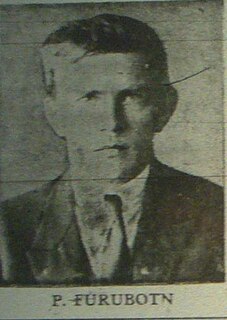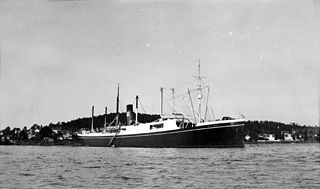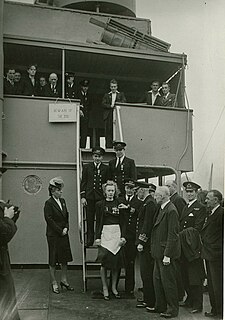Atle Thowsen is a historian and the Director of the Bergen Maritime Museum and served as president of the International Commission for Maritime History from 2000 to 2005.

HNoMS Honningsvåg was a naval trawler that served throughout the Second World War as a patrol boat in the Royal Norwegian Navy. She was launched at the North Sea harbour of Wesermünde in Hanover, Germany in February 1940 as the fishing trawler Malangen and was captured by Norwegian militiamen at the North Norwegian port of Honningsvåg during her maiden fishing journey to the Barents Sea. Having taken part in the defence of Norway in 1940 she spent the rest of the war years patrolling the ocean off Iceland. She was decommissioned in 1946, sold to a civilian fishing company in 1947 and scrapped in 1973.

Peder Furubotn was a Norwegian cabinetmaker, politician for the Communist Party and resistance member during World War II.

SS Henry was a Norwegian steam-powered cargo ship best known for being one of the two ships sunk in one of the most controversial incidents in Norway during the Second World War.

SS Irma was a 1,322-ton steamship built by the British shipyard Sir Raylton Dixon & Co. Ltd. in Middlesbrough in the north-east of England. She was delivered to the Norwegian passenger ship company Det Bergenske Dampskibsselskab of Bergen in 1905. Irma sailed for the company until she was attacked and sunk by two MTBs belonging to the Royal Norwegian Navy on 13 February 1944.

SS Barøy was a 424-ton steel-hulled steamship delivered from the Trondhjems mekaniske Værksted shipyard in Trondheim in 1929. She had been ordered by the Norwegian shipping company Ofotens Dampskibsselskab for the local route from the port city of Narvik to the smaller towns of Lødingen and Svolvær. After the company suffered ship losses in the 1940 Norwegian Campaign Barøy was put into Hurtigruten service on the Trondheim–Narvik route. She was sunk with heavy loss of life in a British air attack in the early hours of 13 September 1941.
Empire Buffalo was a 6,404 GRT Design 1105 cargo ship which was built in 1919 as Eglantine by Skinner & Eddy for the United States Shipping Board (USSB). She was sold in 1933 to the Lykes Brothers-Ripley Steamship Corporation. In 1940 she was sold to the Ministry of War Transport (MoWT) and renamed Empire Buffalo. She was torpedoed and sunk by U-125 in 1942.

Odd Kjell Starheim, DSO was a Norwegian resistance fighter and SOE agent during the Second World War. He died when a Norwegian ship he had captured off the coast of Norway was sunk by German bombers on its way back to the United Kingdom.
Talthybius was a 10,224 GRT Cargo liner that was built in 1911 by Scotts Shipbuilding & Engineering Co Ltd, Greenock, Renfrewshire, United Kingdom for a British shipping line. She was sunk at Singapore in an air raid in 1942. Salvaged by the Japanese, she was renamed Taruyasu Maru, serving with the Imperial Japanese Navy until 1945 when she either struck a mine off Sado Island and sank or was sunk in an attack by aircraft of Task Force 38. She was salvaged by the British, passed to the Ministry of War Transport (MoWT) and renamed Empire Evenlode. She served until 1949, when she was scrapped.
Arnt Jacobsen Mørland was a Norwegian ship-owner, resistance member, and politician for the Christian Democratic Party.
MT Vardaas was a Norwegian oil tanker, built in 1931. She could carry 12,683 DWT. Sailing for Arnt J. Mørland's shipping company and Nortraship, while on its way from Cape Town to Trinidad carrying dead freight, the ship was hit by a torpedo from the German submarine U-564 on 30 August 1942. All crew of 41 escaped in lifeboats and landed in Plymouth Bay, Tobago.
Brynjolv Baardson was a Norwegian sailor and businessperson, and a US Army officer.
Eidsvold was a 4,184 GRT motor vessel built in 1934 at Gothenburg for Norwegian Owners. She was torpedoed and sunk in 1942 by the Japanese submarine I-159.

The kvarstad vessels were a number of Norwegian ships held in arrest in Gothenburg during World War II. The ships had been visiting Swedish ports when the German invasion of Norway took place in April 1940. They were eventually claimed by Nortraship, which represented the Norwegian exile government and the British Government, but also by the Germany-supported Quisling regime in Norway. The fate of the ships was disputed through a number of diplomatic notes and trials between the involved parties. The disputed vessels originally numbered 42 ships, with a total of 170,000 ton dw. Some of the ships returned early to occupied Norway, some after recommendation from the Administrative Council. In January 1941 the British Operation Rubble succeeded in bringing five of the ships to the Orkney Islands.

MV B. P. Newton was a Norwegian tanker built in 1940, and sunk by German submarine off South America in July 1943.
MV Storsten was a Norwegian tanker built in 1926, and sunk by German aircraft in the Skagerrak on 1 April 1942.

HNoMS Storm was a 1.-class torpedo boat constructed in 1898. Storm served the Royal Norwegian Navy for almost 42 years, including neutrality protection duties during the First World War. She was lost in the 1940 Norwegian campaign of the Second World War. During the Norwegian Campaign, she was the only Norwegian warship that launched a torpedo against the invading Germans.

Margit Johnsen Godø,, nicknamed Malta-Margit, was a Norwegian sailor in the merchant navy. For her service on a merchant vessel in convoy to Malta in 1942 she was awarded the St. Olav's Medal with Oak Branch and several other gallantry decorations. Johnsen continued her work in the Norwegian merchant fleet until 1960. Her story is told in maritime and wartime history as an example of Norwegian women's effort during World War II.

MS Torrens was a Norwegian cargo motor ship built in 1939 by Kockums Mek.Verksted AB., Malmö, Sweden, for Wilhelm Wilhelmsen, Tønsberg, Norway. In 1940, after the German invasion of Norway, the ship operated for the Norwegian Shipping and Trade Mission (Nortraship) in London. Voyages in early 1940 involved U.S. Atlantic ports and the Philippines, China and Japan. By mid 1940 the operations tended to be out of U.S. Pacific coast ports, with occasional visits to the Atlantic, to the same destinations. The same pattern repeated in 1941.










